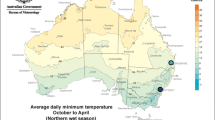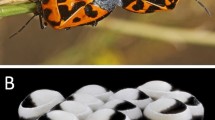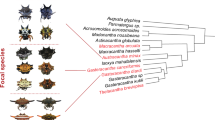Abstract
Camouflage and warning colouration are two important forms of protective colouration. We have studied the detectability of two seasonal colourations in the aposematic striated shieldbug, Graphosoma lineatum. The typical colouration of this insect is red and black, which is also the colouration of the reproductive post-hibernation bugs in our study area in south central Sweden. However, the majority of newly eclosed adults in late summer exhibit a ‘pale’ (light brownish, non-red) and black striation, and these bugs appear quite cryptic to the human eye when sitting on the dried stems and umbels of their host plants. In experiments using photographs of prey in the late-summer habitat shown on a computer screen, we compared the time to detection by human subjects of bugs, which had been manipulated to show either of the two typical seasonal colourations. Time to detection was significantly longer for the pale and black than for the red-and-black striation in images with the bug photographed at two different distances. This indicates that the pale pre-hibernation striation may have a cryptic function. In a separate experiment, we tested detectability of striated and non-striated manipulations of bug pre-hibernation colouration against the late-summer background, and found that time to detection was significantly longer for the striated bugs. We discuss potential functional explanations for the seasonal ontogenetic colour plasticity and suggest that the epidermal pale colour in the late summer provides a benefit of increased camouflage.




Similar content being viewed by others
References
Aldrich JR (1988) Chemical ecology of the Heteroptera. Ann Rev Entomol 33:211–238
Aronsson M, Gamberale-Stille G (2008) Domestic chicks primarily attend to colour, not pattern, when learning an aposematic coloration. Anim Behav 75:417–423. DOI 10.1016/j.anbehav.2007.05.006
Berenbaum MR, Miliczky E (1984) Mantids and milkweed bugs—efficacy of aposematic coloration against invertebrate predators. Am Midl Nat 111:64–68
Cott HC (1940) Adaptive colouration in animals. Methuen, London
Cuthill IC, Partridge JC, Bennett ATD, Church SC, Hart NS, Hunt S (2000) Ultraviolet vision in birds. Adv Stud Behav 29:159–214
Despland E, Simpson SJ (2005) Surviving the change to warning colouration: density-dependent polyphenism suggests a route for the evolution of aposematism. Chemoecology 15:69–75
Edmunds ME (1974) Defence in animals: a survey of anti-predator defences. Longman, Harlow, Essex
Evans DL, Schmidt JO (eds) (1990) Insect defenses: adaptive mechanisms and strategies of prey and predators. State University of New York Press, New York
Exnerová A, Landová E, Stys P, Fuchs R, Prokopová M, Cehláriková P (2003a) Reactions of passerine birds to aposematic and non-aposematic bugs (Pyrrhocoris apterus; Heteroptera). Biol J Linn Soc 78:517–525
Exnerová A, Stys P, Kristín A, Volf O, Pudil M (2003b) Birds as predators of true bugs (Heteroptera) in different habitats. Biologia 58:253–264
Exnerová A, Svádová K, Stys P, Barcalová S, Landová E, Prokopová M, Fuchs R, Socha R (2006) Importance of colour in the reaction of passerine predators to aposematic prey: experiments with mutants of Pyrrhocoris apterus (Heteroptera). Biol J Linn Soc 88:143–153
Fasulati SR (1979) Photoperiodic reaction and coloration of Eurydema oleracea (Hetroptera, Pentatomidae). Entomol Rev 58:10–15
Gamberale-Stille G, Tullberg BS (1999) Experienced chicks show biased avoidance of stronger signals: an experiment with natural colour variation in live aposematic prey. Evol Ecol 13:579–589
Grant JB (2007) Ontogenetic colour change and the evolution of aposematism: a case study in panic moth caterpillars. J Anim Ecol 76:439–447
Hart NS (2001) The visual ecology of avian photoreceptors. Prog Retin Eye Res 20:675–703
Kotaki T (1998) Effects of low temperature on diapause termination and body colour change in adults of a stink bug, Plautia stali. Physiol Entomol 23:53–61
Larsson FK (1986) Female longevity and body size as predictors of fecundity and egg length in Graphosoma lineatum L. (Hemiptera, Pentatomidae). Dtsch Entomol Z 36:329–334
Lindström L, Alatalo RV, Mappes J, Riipi M, Vertainen L (1999) Can aposematic signals evolve by gradual change? Nature 397:249–251
Melber C, Schmidt GH (1994) Quantitative variations in the pteridines during the post-embryonic development of Dysdercus species (Heteroptera: Pyrrhocoridae). Comp Biochem Physiol 108B:79–94
Merilaita S (1998) Crypsis through disruptive coloration in an isopod. Proc R Soc Lond B 265:1059–1064
Merilaita S, Tullberg BS (2005) Constrained camouflage facilitates the evolution of conspicuous warning coloration. Evolution 59:38–45
Merilaita S, Ruxton GD (2007) Aposematic signals and the relationship between conspicuousness and distinctiveness. J Theor Biol 245:268–277
Musolin DL, Saulich AH (2001) Environmental control of voltinism of the stinkbug Graphosoma lineatum in the forest-steppe zone (Heteroptera: Pentatomidae). Entomol Gen 25:255–264
Musolin DL, Numata H (2003) Photoperiodic and temperature control of diapause induction and colour change in the southern green stink bug Nezara viridula. Physiol Entomol 28:65–74
Nakamura K, Hodkova M, Hodek I (1998) Effect of photoperiod on flight activity in Graphosoma lineatum (Heteroptera: Pentatomidae). Eur J Entomol 95:297–300
Niva CC, Takeda M (2002) Color changes in Halyomorpha brevis (Heteroptera: Pentatomidae) correlated with distribution of pteridines: regulation by environmental and physiological factors. Comp Biochem Physiol B 132:653–660
Nylin S, Gamberale-Stille G, Tullberg BS (2001) Ontogeny of defence and adaptive coloration in larvae of the comma butterfly, Polygonia calbum (Nymphalidae). J Lepid Soc 55:69–73
Ödéen A, Håstad O (2003) Complex distribution of avian colour vision systems revealed by sequencing the SWS1 opsin from total DNA. Mol Biol Evol 20:855–861
Paradise CJ, Stamp NE (1991) Prey recognition time of praying mantids (Dictyoptera: Mantidae) and consequent survivorship of unpalatable prey (Hemiptera: Lygaeidae). J Insect Behav 4:265–273
Poulton EB (1890) The colours of animals: their meaning and use especially considered in the case of insects. Kegan Paul, London
Remold H (1963) Scent-glands of land bugs, their physiology and biological function. Nature 198:764–768
Ruxton GD, Sherratt TN, Speed MP (2004) Avoiding attack. Oxford University Press, Oxford
Saunders E (1892) The hemiptera heteroptera of the British Islands. L. Reeve, London
Schaefer HM, Stobbe N (2006) Disruptive coloration provides camouflage independent of background matching. Proc R Soc Lond B 273:2427–2432
Schlee MA (1986) Avian predation on Heteroptera: experiments on the European Blackbird Turdus m. merula L. Ethology 73:1–18
Scudder GGE, Duffey SS (1972) Cardiac glycosides in the Lygaeinae (Hemiptera, Lygaeidae). Can J Zoology 50:35–42
Sherratt TN, Beatty CD (2003) The evolution of warning signals as reliable indicators of prey defense. Am Nat 162:377–389
Slachta M, Vambera J, Zahradnickova H, Kostal V (2002) Entering diapause is a prerequisite for successful cold-acclimation in adult Graphosoma lineatum (Heteroptera: Pentatomidae). J Insect Physiol 48:1031–1039
Socha R, Nemec V (1996) Coloration and pteridine pattern in a new, yolk body mutant of Pyrrhocoris apterus (Heteroptera Pyrrhocoridae). Eur J Entomol 93:525–534
Speed MP, Ruxton GD (2005) Aposematism: what should our starting point be. Proc R Soc Lond B 272:431–438
Stehlik JL (1984) Results of the investigations on Hemiptera in Moravia made by the Moravian Museum (Pentatomoidea III). Acta Mus Morav Sci Nat 69:163–185
Stevens M, Cuthill IC, Windsor AMM, Walker HJ (2006) Disruptive contrast in animal camouflage. Proc R Soc Lond B 273:2433–2438
Stichel W (1960) Illustrierte Bestimmungstabellen der Wanzen. II Europa (Hemiptera-Heteroptera Europae), vol. 4. Hermsdorf, Berlin
Stransky K, Valterova I, Ubik K, Cajka J, Krecek J (1998) Volatiles from stink bug, Graphosoma lineatum (L.), and from green shield bug, Palomena prasina (L.), (Heteroptera: Pentatomidae). J High Resolut Chromatogr 21:475–476
Sword GA (2002) The role of phenotypic plasticity in the evolution of aposematism. Proc R Soc Lond B 269:1639–1644
Tietz D, Zrzavý J (1996) Dorsoventral pattern formation: morphogenesis of longitudinal coloration in Graphosoma lineatum (Heteroptera: Pentatomidae). Eur J Entomol 93:15–22
Tullberg BS, Merilaita S, Wiklund C (2005) Aposematism and crypsis combined as a result of distance dependence: functional versatility of the colour pattern in the swallowtail butterfly larva. Proc R Soc Lond B 272:1315–1321
Vesely P, Veselá S, Fuchs R, Zrzavy J (2006) Are gregarious red-black shieldbugs, Graphosoma lineatum (Hemiptera: Pentatomidae), really aposematic? An experimental approach. Evol Ecol Res 8:881–890
Wagner E (1956) Zur Systematik der Gattung Graphosoma Lap. (Hem., Het. Pentatomidae). Entomol Ber 16:110–116
Wiklund C, Sillén-Tullberg B (1985) Why distasteful butterflies have aposematic larvae and adults, but cryptic pupae: evidence from predation experiments on the monarch and European swallowtail. Evolution 39:1155–1158
Wüster W, Allum CSE, Bjargardottir IB, Bailey KL, Dawson KJ, Guenioui J, Lewis J, McGurk J, Moore AG, Niskanen M, Pollard CP (2004) Do aposematism and Batesian mimicry require bright colours? A test, using European viper markings. Proc R Soc Lond B 271:2495–2499
Zrzavý J (1994) Red bugs and the origin of mimetic complexes (Heteroptera: Pyrrhocoridae: Neotropical Dysdercus spp.). Oikos 69:346–352
Zrzavý J, Nedved O (1999) Evolution of mimicry in the New World Dysdercus (Hemiptera: Pyrrhocoridae). J Evol Biol 12:956–969
Acknowledgements
We are indebted to Dr. Olle Brick, Felicia Dinnetz and Rasmus Neideman for their invaluable help with the organisation of the photo image experiments. We are especially grateful to the many students at Norra Real for their participation as subjects. We thank Carl-Cedric Coulianos, Alice Exnerová, Pavel Stys and Christer Wiklund for valuable comments on earlier drafts of the manuscript. This study was financially supported by the Swedish Research Council (to B.S.T., G.G.S. and S.M.). The experiments in this study fully comply with current Swedish legislation.
Author information
Authors and Affiliations
Corresponding author
Additional information
Communicated by D. Gwynne
Rights and permissions
About this article
Cite this article
Tullberg, B.S., Gamberale-Stille, G., Bohlin, T. et al. Seasonal ontogenetic colour plasticity in the adult striated shieldbug Graphosoma lineatum (Heteroptera) and its effect on detectability. Behav Ecol Sociobiol 62, 1389–1396 (2008). https://doi.org/10.1007/s00265-008-0567-7
Received:
Revised:
Accepted:
Published:
Issue Date:
DOI: https://doi.org/10.1007/s00265-008-0567-7




